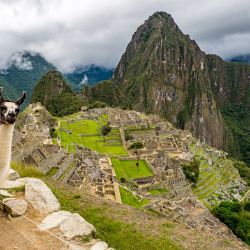For my monthly installment of the macabre, the fascinating discovery by archaeologists of more than 140 children and 200 young llamas on Peru’s northern coast won’t disappoint. With apparent physical signs of a single incident ritualistic killing, scientists sponsored by the National Geographic Society hope to elucidate the what, when, where, how and, most importantly, why of this mass tragedy.
According to National Geographic, this is what we already know
Huanchaquito-Las Llamas is the official name for the coastal site. Remains were first found in 2011 when local residents noticed them due to sediment erosion, with completion of the excavation occurring in 2016. Radiocarbon dating was used on funerary objects to isolate the timeline from 1400 to 1450 A.D. Red cinnabar-based pigment was smeared across many of the children’s faces before their chests were sliced open presumably to remove their hearts.
The skeletal bones - both human and animal - suggest one or more well-trained individuals exacted precise cuts to the sternum and ribs. The male and female children range from ages 5-14 (predominantly 8-12) years old and the llamas less than 18 months old. Blunt-force head trauma was the cause of death in the three adults whose bodies were also found. (To see photos from the site and learn more, see detailed account here).
How do we know these things
Experts can determine from patterns (e.g. jagged or straight, superficial or deep) whether injuries are sustained through a surgical strike or traumatic struggle, for example. In these instances, it appears chests were intentionally cut open severing sternums in half and dislocating ribs. The lack of hesitation marks and uniform nature of them speaks to the high level of training of the perpetrator(s). Footprint analysis from mud evidence (e.g. skid depth reflects resistance to action) of dog, human and llama origin points to a solitary event with compulsory participation. They can track from this information the direction of the procession and determine where the ritual sacrifice and burial took place.
What’s the deal with human sacrifice
Apparently, scientists believe, of the many human sacrifices unearthed around the world, they stem from a need to play “an important role in the development of complex societies through social stratification and control of populations by elite social classes.” Adults were traditionally used. It is hypothesized here that inclement weather changes upped the ante and adults wouldn’t suffice. Haagen Klaus, professor of anthropology at George Mason University, suggests
“People sacrifice that which is of most and greatest value to them...They may have seen that [adult sacrifice] was ineffective. The rains kept coming. Maybe there was a need for a new type of sacrificial victim...There’s this idea that ritual killing is contractual, that it’s performed to get something from supernatural deities. But it’s actually a much more complicated attempt at negotiation with those supernatural forces and their manipulation by the living.”
Now what
The investigating team is performing extensive, tedious analysis and testing to determine more about the deceased and how they lived. Their work is not limited to the site but extends beyond its borders so as to learn more about the ongoings of the time and the histories of those involved (as well as other lessons from the world). An official report is underway for submission for journal publication.
Take Home Message
We live in pretty exciting times, especially in terms of medical progress and scientific advancement. There has been such innovation in the world of forensic science that a rather detailed account of the events of Huanchaquito-Las Llamas is likely forthcoming sooner than we can imagine.
What is of particular note is the fact that such interpretations could not be possible without comprehensive, multidisciplinary techniques and expertise that range from bioarchaeologists to physical anthropologists, pathologists and environmental scientists. And, now with such elaborate tools for communication, collaborations have gone global.
To appreciate modern developments in this realm, check out these pieces with more detailed science:

